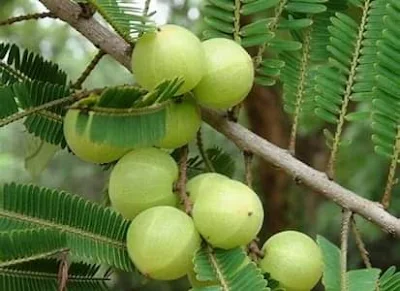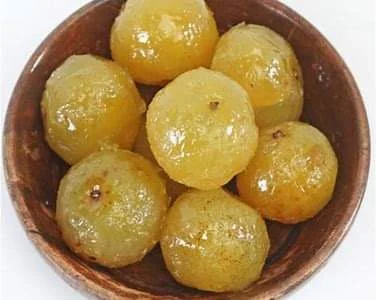Amla Murabba proves the fact that "Ek amla, anek faydey" meaning one fruit, many benefits , and Amla or Indian gooseberry holds the pride of place in Indian Ayurveda, and Unani
Amla Murabba
Did you know that Amla Murabba proves the fact that "Ek amla, anek faydey" (meaning one fruit, many benefits), and Amla or Indian gooseberry holds the pride of place in Indian Ayurveda, and Unani?
Amla Murabba, as sweetened preserve, a popular confection, adopted as a functional food, is considered a medicinal prescription in the Indian Ayurveda, and folk medicine, with fresh fruits of Amla or Indian Gooseberry (Emblica officinalisor) as the basic ingredient with sugar and spices as an additive for a longer shelf life. An easy recipe involves first washing the fruit and dipping it with fitcari (alum) in water for 3 days, then making three or four cuts on each gooseberry with a knife or a fork, then boiling the fruits in water in a vessel till the fruits become tender, drying the cooked fruit, and then dipping them and stirring in spiced (Cardamom and Kesar) sugar syrup, and allowing it to remain in the syrup for at least a week before use. Some also make it by first steaming Amlas and then dipping them in sugar syrup.
Amla means gooseberry fruit, and Murabba also spelled murraba or murrabo is an Arabic word that refers to savoury or sweet jam pickle or achar in many regions of India, Pakistan, Iran, South Caucasus, Central Asia, South Asia, and the Middle East. Apart from Amla, other fruits such as apple, apricot, ginger (Zingiber officinale), pineapple (Ananas sativus), mango, plum, quince, stone apple (Aegle marmelos), ash gourd (Benincasa hispida), are also preserved as murabbas with sugar, and spices in wet or dry form.
It is also said that Murabba originated in the land of Gurjistan, present day Republic of Georgia. The people of the land, in fear of invaders, migrated to Gujarat and neighboring areas in India. Once they settled down in Gujarat then they started making and consuming murabba as a popular confection and functional food made from Amla and various other local fruits.
In India, Amla is given a pride of place as a miracle fruit with the saying "Ek amla, anek faydey" (meaning one fruit, many benefits) is widely recommended for use in the form of a murabba for many ailments, particularly for enhancing immunity of the body. Amla is neon-green in colour and has an unusual taste. It is a powerhouse of nutrients - polyphenols, vitamin C, vitamin A, calcium, magnesium, zinc, copper and iron among others. Gooseberry's (Amla's) special characteristic is that even when heated on fire or boiled, it does not loose its chemical ingredients. Every part of the fruit-rind, pulp, seed, etc is used for medicinal purposes , beside the tree purifying the air.
In religious circles among Hindus, Amla is sacred on Akshya Navami in the month of Kartik (October-November) and during Amalaka Ekadashi day (on the 11th day (Ekadashi) of the waxing moon, in the lunar month of Phalgun (February–March)), consumed as food under the Amla tree, after worship, ensures long life.
Amla Murabba is recommended as a curative in Ayurveda and Unani for a wide range human ailments. Used daily to overcome general weakness, to improve immunity, strengthens mental faculty, sharpens memory, cure bleeding piles, enlivens heart and liver, as cure for cough and cold, peptic ulcer, for mother-to-be during pregnancy for health of both mother and baby and prevents hair fall due to hormonal changes in the mother's body, help oversee cholesterol levels in the blood, relieves arthritis pain, etc.
- Narasipur Char
























Comments
Post a Comment